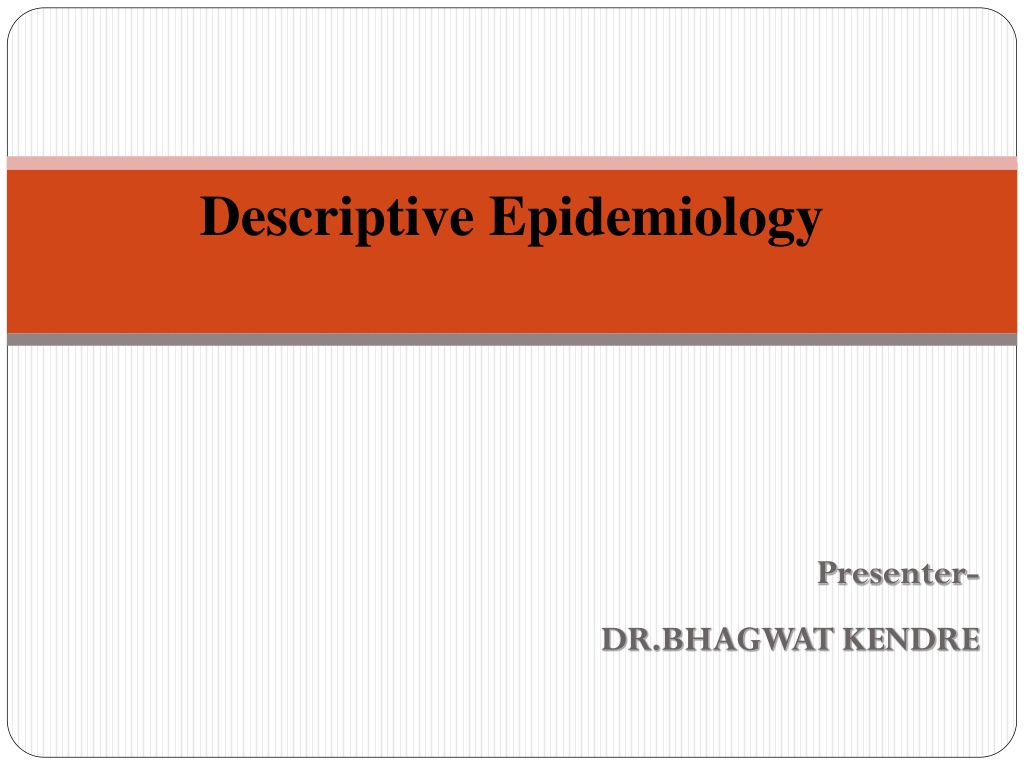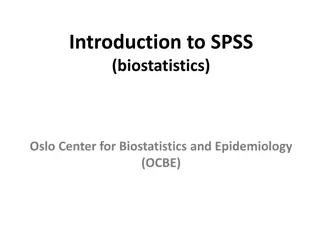Descriptive Epidemiology for Health Analysis
Descriptive Epidemiology, presented by Dr. Bhagwat Kendre, explores the distribution of diseases and related characteristics within populations. The study delves into factors like time, place, and person to identify patterns and formulate hypotheses about disease occurrence. Utilizing data from descriptive studies, researchers can assess disease burden, investigate aetiology, and inform public health interventions effectively.
Download Presentation

Please find below an Image/Link to download the presentation.
The content on the website is provided AS IS for your information and personal use only. It may not be sold, licensed, or shared on other websites without obtaining consent from the author.If you encounter any issues during the download, it is possible that the publisher has removed the file from their server.
You are allowed to download the files provided on this website for personal or commercial use, subject to the condition that they are used lawfully. All files are the property of their respective owners.
The content on the website is provided AS IS for your information and personal use only. It may not be sold, licensed, or shared on other websites without obtaining consent from the author.
E N D
Presentation Transcript
Descriptive Epidemiology Presenter- DR.BHAGWAT KENDRE
Contents Introduction Uses of descriptive epidemiology Procedures in descriptive studies 1. Defining the population to be studied 2. Defining the disease under study 3. Describing the disease by a,. Time - Short-term fluctuations - Periodic fluctuations - Long-term or secular trends b. Place - International variations - National variations - Rural-urban differences - Local distributions c. Person
4. 5. 6. Measurement of disease Comparing with known indices Formulation of an aetiological hypothesis Conclusion References
Introduction Epidemiology is derived from the word epidemic epi = among demos = people logos = study study distribution is the of the and Epidemiology determinants of health-related states or events in specified populations, and the application of this study to the control of health problems .
Descriptive studies are usually the first phase of an epidemiological investigation. These studies are concerned with observing the distribution of disease or health related characteristics in human populations characteristics with which the disease in question seems to be associated. and identifying the
Such studies basically ask the questions When is the disease occurring? - Time distribution Where is it occurring? - Place distribution Who is getting the disease? -Person distribution a) b) c)
Uses of descriptive epidemiology Provide data regarding the magnitude of the disease load and types of disease problems in the community in terms of morbidity and mortality rates and ratios. Provide clues to disease aetiology, and help in the formulation of an aetiological hypothesis. Provide background data for planning, organizing and evaluating preventive and curative services. They contribute to research by describing variations in disease occurrence by time, place and person.
Procedures in descriptive studies Defining the population to be studied Defining the disease under study Describing the disease by Time Place Person Measurement of disease Comparing with known indices Formulation of an aetiological hypothesis 1. 2. 3. a. b. c. 4. 5. 6.
1. Defining the population Descriptive studies are investigations of populations, not individuals. The defined population can be the whole population in a geographic area, or more often a representative sample taken from it. The defined population can also be a specially selected group such as age and sex groups, occupational groups, hospital patients, school children.
2. Defining the disease under study Once the population to be studied is defined or specified, then define the disease or condition being investigated. 3. Describing the disease The primary objective of descriptive epidemiology is to describe the occurrence and distribution of disease by time, place and person.
Time distribution The pattern of disease may be described by the time of its occurrence, i.e., by week, month, year, the day of the week, hour of onset. It raises questions whether the disease is seasonal in occurrence; whether it shows periodic increase or decrease; or whether it follows a consistent time trend. Epidemiologists have identified three kinds of time trends in disease occurrence I. Short-term fluctuations II. Periodic fluctuations III. Long-term or secular trends
I. Short-term fluctuations The best known short-term fluctuation in the occurrence of a disease is an epidemic. Types of epidemics A. Common source epidemics i)Single exposure or point source epidemics ii) Continuous or multiple exposure epidemics B. Propagated epidemics i) Person-to-person ii)Arthropod vector iii)Animal reservoir C. Slow epidemics
A. Common source epidemics i) Single exposure or point source epidemics The exposure to the disease agent is brief and essentially simultaneous, the resultant cases all develop within one incubation period of the disease e.g., an epidemic of food poisoning
ii) Continuous or multiple exposure epidemics Sometimes the exposure from the same source may be prolonged- continuous, repeated or intermittent not necessarily at the same time or place. Example, a well of contaminated water, or a nationally distributed brand of vaccine (e.g. polio vaccine), or food, could result in similar outbreaks.
B. Propagated epidemics A propagated epidemic is most often of infectious origin and results from person to person transmission of an infectious agent. Epidemics of hepatitisAand polio
II. Periodic fluctuations Seasonal trend: For example, measles is usually at its height in early spring and so is varicella. Upper respiratory infections frequently show a seasonal rise during winter months. Bacterial gastrointestinal infections are prominent in summer months. i)
ii) Cyclic trend: Some diseases occur in cycles spread over short periods of time which may be days, weeks, months or years. For example, measles in the pre-vaccination era appeared in cycles with major peaks every 2-3 years and rubella every 6-9 years. Non infectious conditions may also show periodic fluctuations, e.g., automobile accidents in US are more frequent on week-ends, especially Saturdays.
III. Long term or secular trends The term secular trend implies changes in the occurrence of disease over a long period of time, generally several years or decades. Examples include coronary heart disease, lung cancer and diabetes which have shown a consistent upward trend in the developed countries during the past 50 years.
Place Distribution Studies of the geography of disease is one of the important dimensions of descriptive epidemiology. At a broader level, international comparisons may examine mortality and morbidity in relation to socio economic factors, dietary differences and the differences in culture and behaviour. These variations may be classified as: International variations National variations Rural-urban differences Local distributions a. b. c. d.
International variations For example, cancer exists all over the world. There is a marked difference between the incidence of each cancer in different parts of the world. Thus cancer of the stomach is very common in Japan, but unusual in US. Cancers of the oral cavity and uterine cervix are common in India as compared to industrialized countries.
National variations It is obvious that variations in disease occurrence must also exist within countries or national boundaries. For example the distribution of endemic goitre, fluorosis, leprosy, malaria, nutritional deficiency diseases have all shown variations in their distribution in India.
Rural- urban variations For example chronic bronchitis, accidents, lung cancer, cardiovascular diseases and drug dependence are usually more frequent in urban than in rural areas. On other hand, skin and zoonotic diseases and soil transmitted helminths may be more frequent in rural areas than in urban areas.
Local distributions Inner and outer city variations in disease frequency are well known. These variations are best studied with the aid of spot maps or shaded maps . These maps show at a glance areas of high or low frequency, the boundaries and patterns of disease distribution.
Person Distribution In characterized by defining the persons who develop the disease by age, sex, occupation, marital status, habits, social class and other host factor. descriptive studies, the disease is further
Age : Certain diseases are more frequent in certain age groups than in others, e.g., measles in childhood, cancer in middle age and atherosclerosis in old age. Sex : Sex is another host characteristic which is often studied in relation to disease, using such indices as sex-ratio, sex-specific morbidity and mortality rates. It has been found that certain chronic diseases such as diabetes, hyperthyroidism and obesity are more common in women than in men, and diseases such as lung cancer and coronary heart disease are less frequent in women.
Marital status : In countries where studies on mortality in relation to marital status have been conducted, it was found mortality rates were always lower for married males and females than for the unmarried, of the same age and sex. Married persons are generally more secure and protected and they usually lead a more sober life than those who are unmarried. All these factors are thought to contribute to lower mortality rates among married persons.
Occupation : It is now well recognized that man s occupation from which he earns his livelihood has an important bearing on his health status. Occupation may alter the habit pattern of employees e.g., sleep, alcohol, smoking, drug addiction, night shift. It is obvious that persons working in particular occupations are exposed to particular types of risks. For instance, while workers in coal mines are more likely to suffer from silicosis, those in sedentary occupations face the risk of heart disease.
Social class : Epidemiological studies have shown that health and diseases are not equally distributed in social classes. Individuals in the upper social classes have a longer life expectancy and better health and nutritional status than those in the lower social classes. Certain diseases like coronary heart disease, hypertension, diabetes have shown a higher prevalence in upper classes than in the lower classes.
Behaviour : Human behaviour is increasingly looked upon as a risk factor in modern day diseases such as coronary heart disease, cancer, obesity and accidents. Stress : Stress has been shown to affect a variety of variables related to patients response, e.g., susceptibility to disease, exacerbation of symptoms, compliance with medical regimen
Migration : In India diseases like leprosy, filaria and malaria are considered to be rural problems. However, because of the movement of people from rural to urban areas these diseases have created a serious problem in urban areas also.
IV. Measurement of disease It is mandatory to have a clear picture of the amount of disease in the population. This information should be available in terms of mortality, morbidity, disability and so on. Measurement of mortality is straightforward. Morbidity has two aspects incidence and prevalence Incidence can be obtained from longitudinal studies and prevalence from cross sectional studies. Descriptive epidemiology may use a cross sectional or longitudinal design to obtain estimates of magnitude of health and disease problems in human populations.
V. Comparing with known indices By making comparisons between different populations, and subgroups of the same population, it is possible to arrive at clues to disease aetiology. We can also identify for define groups which are at increased risk for certain diseases.
VI. Formulation of a hypothesis By studying the distribution of disease, and utilizing the techniques of descriptive epidemiology, it is often possible to formulate hypothesis relating to disease aetiology. A hypothesis is a supposition, arrived at from observation or reflection. It can be accepted or rejected, using the techniques of analytical epidemiology.
Conclusion Descriptive epidemiology classifies the occurrence of disease according to the variables of person, place, and time. Descriptive epidemiologic studies aid in generating hypotheses that can be explored by analytic epidemiologic studies. Descriptive studies include case reports, case studies, and cross-sectional studies.
REFERENCES Park K. Textbook of preventive and social medicine 22nded. Bhanot publishers,60-67.























